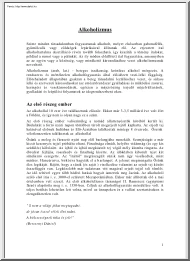Datasheet
Year, pagecount:2012, 2 page(s)
Language:English
Downloads:2
Uploaded:June 11, 2018
Size:614 KB
Institution:
-
Comments:
Attachment:-
Download in PDF:Please log in!
Comments
No comments yet. You can be the first!Most popular documents in this category
Content extract
Source: http://www.doksinet Drug Fact Sheet Cocaine Overview Cocaine is an intense, euphoria-producing stimulant drug with strong addictive potential. Street names Coca, Coke, Crack, Flake, Snow, Soda Cot Looks like Cocaine is usually distributed as a white, crystalline powder. Cocaine is often diluted (“cut”) with a variety of substances, the most common of which are sugars and local anesthetics. It is “cut” to stretch the amount of the product and increase profits for dealers In contrast, cocaine base (crack) looks like small, irregularly shaped chunks (or “rocks”) of a whitish solid. Methods of abuse Powdered cocaine can be snorted or injected into the veins after dissolving in water. Cocaine base (crack) is smoked, either alone or on marijuana or tobacco. Cocaine is also abused in combination with an opiate, like heroin, a practice known as “speedballing.” Although injecting into veins or muscles, snorting, and smoking are the common ways of using cocaine, all
mucous membranes readily absorb cocaine. Cocaine users typically binge on the drug until they are exhausted or run out of cocaine. Affect on mind The intensity of cocaine’s euphoric effects depends on how quickly the drug reaches the brain, which depends on the dose and method of abuse. Following smoking or intravenous injection, cocaine reaches the brain in seconds, with a rapid buildup in levels. This results in a rapid-onset, intense euphoric effect known as a “rush” By contrast, the euphoria caused by snorting cocaine is less intense and does not happen as quickly due to the slower build-up of the drug in the brain. Other effects include increased alertness and excitation, as well as restlessness, irritability, and anxiety. Tolerance to cocaine’s effects develops rapidly, causing users to take higher and higher doses Taking high doses of cocaine or prolonged use, such as binging, usually causes paranoia. The crash that follows euphoria is characterized by mental and
physical exhaustion, sleep, and depression lasting several days. Following the crash, users experience a craving to use cocaine again. Affect on body Physiological effects of cocaine include increased blood pressure and heart rate, dilated pupils, insomnia, and loss of appetite. The widespread abuse of highly pure street cocaine has led to many severe adverse health consequences such as: cardiac arrhythmias, ischemic heart conditions, sudden cardiac arrest, convulsions, strokes, and death. In some users, the long-term use of inhaled cocaine has led to a unique respiratory syndrome, and chronic snorting of cocaine has led to the erosion of the upper nasal cavity. Drugs causing similar effects Other stimulants, such as methamphetamine, cause effects similar to cocaine that vary mainly in degree. Overdose effects Overdose effects include agitation, increased body temperature, hallucinations, convulsions and possible death. Legal status in the United States Cocaine is a Schedule II
drug under the Controlled Substances Act, meaning it has a high potential for abuse and limited medical usage. Cocaine hydrochloride solution (4% and 10%) is used primarily as a topical local anesthetic for the upper respiratory tract. It also is used to reduce bleeding of the mucous membranes in the mouth, throat, and nasal cavities. However, better products have been developed for these purposes, and cocaine is rarely used medically in the United States. Drug Enforcement Administration Common places of origin • For more information, visit www.deagov Source: http://www.doksinet Physiological effects of cocaine include increased blood pressure and heart rate, dilated pupils, insomnia, and loss of appetite. The widespread abuse of highly pure street cocaine has led to many severe adverse health consequences such as: cardiac arrhythmias, ischemic heart conditions, sudden cardiac arrest, convulsions, strokes, and death. In some users, the long-term use of inhaled cocaine has led
to a unique respiratory syndrome, and chronic snorting of cocaine has led to the erosion of the upper nasal cavity. Drug Fact Sheet Cocaine – cont’d. Other stimulants, such as methamphetamine, cause effects similar to cocaine that vary mainly in degree. Drugs causing similar effects Overdose effects Overdose effects include agitation, increased body temperature, hallucinations, convulsions and possible death. Legal status in the United States Cocaine is a Schedule II drug under the Controlled Substances Act, meaning it has a high potential for abuse and limited medical usage. Cocaine hydrochloride solution (4% and 10%) is used primarily as a topical local anesthetic for the upper respiratory tract. It also is used to reduce bleeding of the mucous membranes in the mouth, throat, and nasal cavities. However, better products have been developed for these purposes, and cocaine is rarely used medically in the United States. Common places of origin Cocaine is derived from coca leaves
grown in Bolivia, Peru, and Colombia. The cocaine manufacturing process takes place in remote jungle labs where the raw product undergoes a series of chemical transformations. Colombia produces about 90% of the cocaine powder reaching the United States. According to the 2005 Colombia Threat Assessment, 90% of the cocaine shipped to the United States comes from the Central America-Mexico corridor. This content came from a United States Government, Drug Enforcement Administration (DEA) website, www.getsmartaboutdrugscom Drug Enforcement Administration • For more information, visit www.deagov
mucous membranes readily absorb cocaine. Cocaine users typically binge on the drug until they are exhausted or run out of cocaine. Affect on mind The intensity of cocaine’s euphoric effects depends on how quickly the drug reaches the brain, which depends on the dose and method of abuse. Following smoking or intravenous injection, cocaine reaches the brain in seconds, with a rapid buildup in levels. This results in a rapid-onset, intense euphoric effect known as a “rush” By contrast, the euphoria caused by snorting cocaine is less intense and does not happen as quickly due to the slower build-up of the drug in the brain. Other effects include increased alertness and excitation, as well as restlessness, irritability, and anxiety. Tolerance to cocaine’s effects develops rapidly, causing users to take higher and higher doses Taking high doses of cocaine or prolonged use, such as binging, usually causes paranoia. The crash that follows euphoria is characterized by mental and
physical exhaustion, sleep, and depression lasting several days. Following the crash, users experience a craving to use cocaine again. Affect on body Physiological effects of cocaine include increased blood pressure and heart rate, dilated pupils, insomnia, and loss of appetite. The widespread abuse of highly pure street cocaine has led to many severe adverse health consequences such as: cardiac arrhythmias, ischemic heart conditions, sudden cardiac arrest, convulsions, strokes, and death. In some users, the long-term use of inhaled cocaine has led to a unique respiratory syndrome, and chronic snorting of cocaine has led to the erosion of the upper nasal cavity. Drugs causing similar effects Other stimulants, such as methamphetamine, cause effects similar to cocaine that vary mainly in degree. Overdose effects Overdose effects include agitation, increased body temperature, hallucinations, convulsions and possible death. Legal status in the United States Cocaine is a Schedule II
drug under the Controlled Substances Act, meaning it has a high potential for abuse and limited medical usage. Cocaine hydrochloride solution (4% and 10%) is used primarily as a topical local anesthetic for the upper respiratory tract. It also is used to reduce bleeding of the mucous membranes in the mouth, throat, and nasal cavities. However, better products have been developed for these purposes, and cocaine is rarely used medically in the United States. Drug Enforcement Administration Common places of origin • For more information, visit www.deagov Source: http://www.doksinet Physiological effects of cocaine include increased blood pressure and heart rate, dilated pupils, insomnia, and loss of appetite. The widespread abuse of highly pure street cocaine has led to many severe adverse health consequences such as: cardiac arrhythmias, ischemic heart conditions, sudden cardiac arrest, convulsions, strokes, and death. In some users, the long-term use of inhaled cocaine has led
to a unique respiratory syndrome, and chronic snorting of cocaine has led to the erosion of the upper nasal cavity. Drug Fact Sheet Cocaine – cont’d. Other stimulants, such as methamphetamine, cause effects similar to cocaine that vary mainly in degree. Drugs causing similar effects Overdose effects Overdose effects include agitation, increased body temperature, hallucinations, convulsions and possible death. Legal status in the United States Cocaine is a Schedule II drug under the Controlled Substances Act, meaning it has a high potential for abuse and limited medical usage. Cocaine hydrochloride solution (4% and 10%) is used primarily as a topical local anesthetic for the upper respiratory tract. It also is used to reduce bleeding of the mucous membranes in the mouth, throat, and nasal cavities. However, better products have been developed for these purposes, and cocaine is rarely used medically in the United States. Common places of origin Cocaine is derived from coca leaves
grown in Bolivia, Peru, and Colombia. The cocaine manufacturing process takes place in remote jungle labs where the raw product undergoes a series of chemical transformations. Colombia produces about 90% of the cocaine powder reaching the United States. According to the 2005 Colombia Threat Assessment, 90% of the cocaine shipped to the United States comes from the Central America-Mexico corridor. This content came from a United States Government, Drug Enforcement Administration (DEA) website, www.getsmartaboutdrugscom Drug Enforcement Administration • For more information, visit www.deagov





